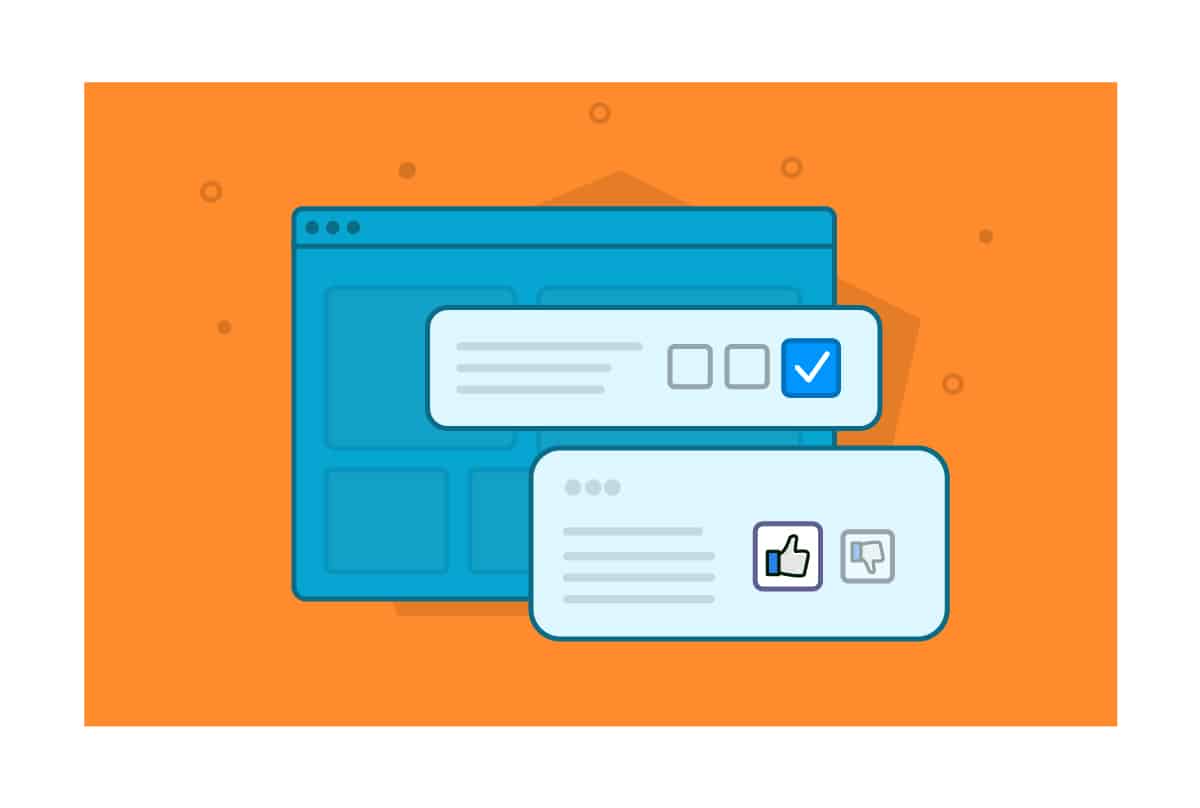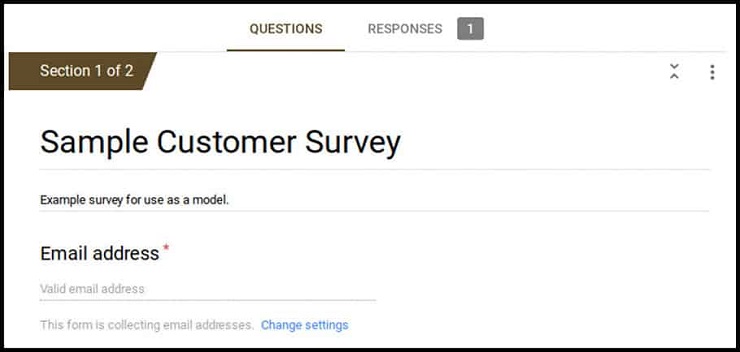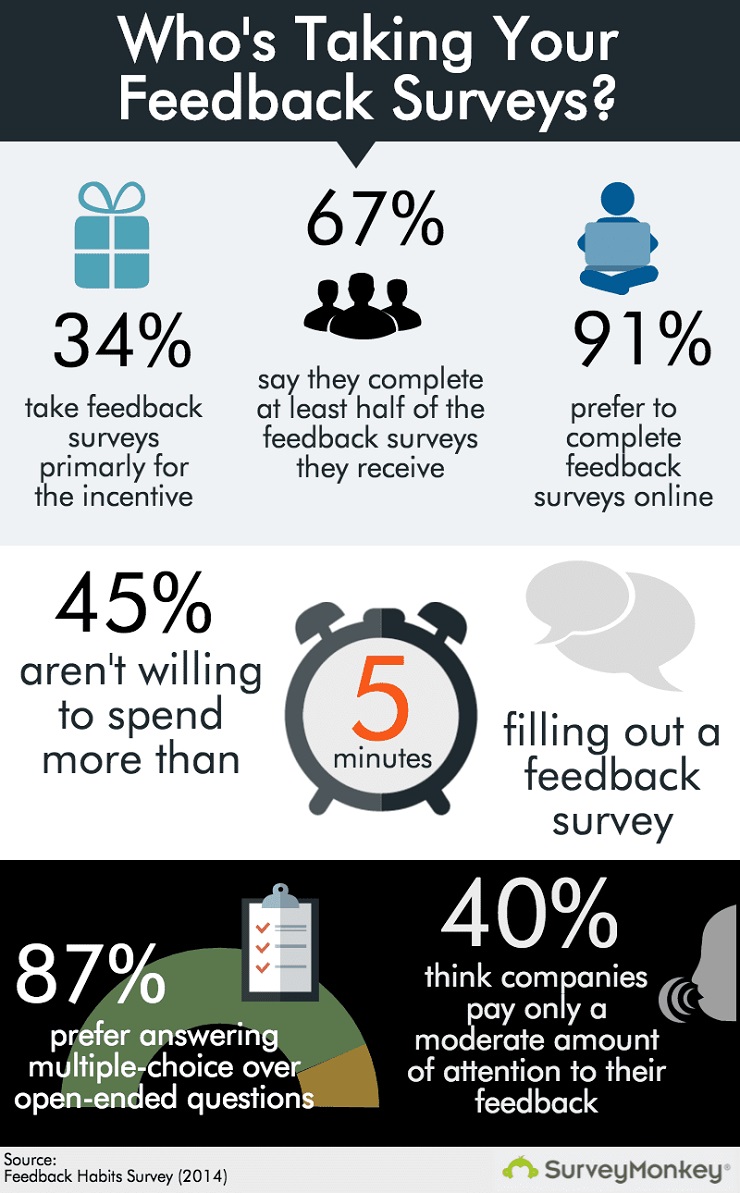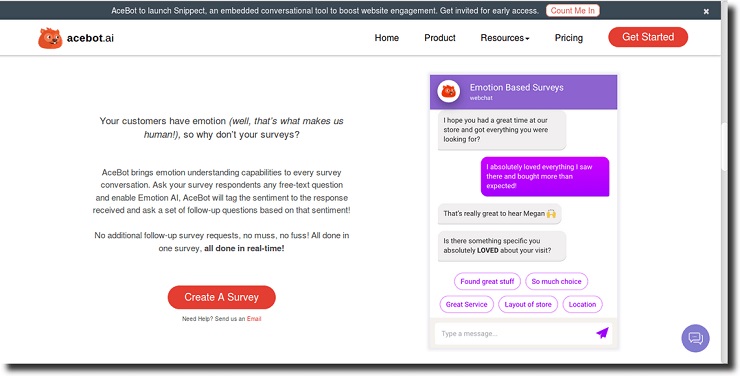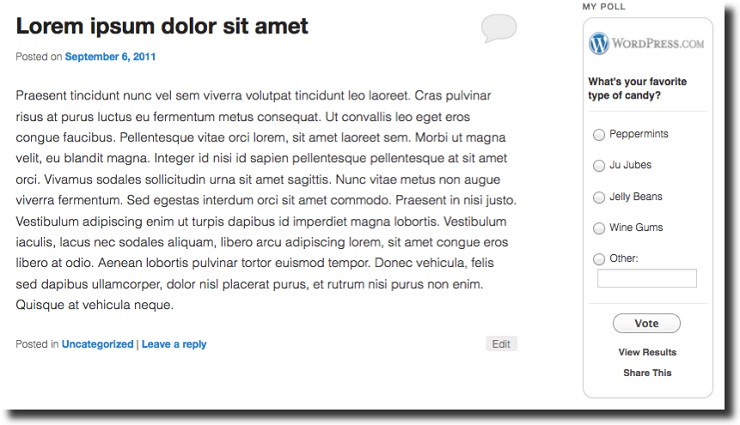All that research, all that speculation, all the analytics, all those avatars. Oh, the things we do to understand what our audiences want from us. Here’s a bright idea—why don’t we just ask them?
Surveys may seem a little old-fashioned, but they remain one of the most effective and efficient tools in marketing, as they help you understand how to develop your marketing strategy and how to attract and convert new customers by getting to know your audience better.
For example, the experience of Eneco company shows that it’s possible to generate 1,000 leads in six weeks with a single survey.
While they’re commonly used for collecting feedback after a purchase, surveys can be used for many other purposes, including to:
- Help to shape a marketing strategy
- Allow you to define the needs of your target audience
- Gather opinions on your marketing campaigns
- Help you find your business’s weak spots
- Find new channels of communication with your target audience
- Sign up new leads
EXCLUSIVE FREE TRAINING: Successful Founders Teach You How to Start and Grow an Online Business
By asking the right questions, you can gather not only emails for future campaigns, but also useful information about your respondents that increases the chances of converting and retaining them down the road.
After reading this article, you’ll know how to effectively survey your target audience and use the results to develop your content strategy, increase the attractiveness of your brand, and ultimately, grow your business.
Benefits of Great User Surveys
Understanding Common Pain Points
Surveys are great for collecting information from website visitors so you can figure out what specific difficulties they face daily and what their pain points are. While each person is unique, marketing wouldn’t exist if we couldn’t identify common problems among different people.
By answering industry survey questions, users might share some common problems that will allow you to divide leads into groups and deliver key messages considering the specifics of each group. That way, you can define the reasons why a certain group visited your website, or what their main motivation might be for using your product or service in the future.
For example, if you sell organic fertilizer, your website will likely be visited by many groups of people from farming business owners to gardening enthusiasts. Their everyday problems, like facing soil salinity or struggling with poor harvest are similar, while their motivations to buy your product might be different. Typically, farming business owners strive for increasing their income while gardening enthusiasts are eager to grow plants that appeal to them personally.
By sending emails with different key messages for these two groups, you can improve the effectiveness of your email campaigns. Business owners will probably be more interested in numbers, so you could add some statistics to their emails. Gardening enthusiasts will love pictures of beautiful or rare flowers, which you could add to your emails for this group.
Collecting information on your target audience’s pain points—specific problems they experience—provides a lot of opportunities. You can:
- Make your ads more targeted and personalized
- Define the most effective email marketing strategy
- Create key messages for different groups of visitors
- Address your audience’s pain points through the right platform to attract the attention of your target audience
- Identify what new or improved products and services are more suitable for the needs of your target audience
For another example, let’s say your audience’s main problem is managing their schedules on a daily basis. With a survey, you can dig down into this problem.
Questions to ask:
1. What do you find the most challenging about ?
Ex: What do you find the most challenging about managing your daily schedule?
2. What is your current issue with ?
Ex: What is your current issue with your daily scheduling process?
3. Have you considered any options to solve ? Which options?
Ex: Have you considered any options to improve your daily scheduling process? Which options?
Creating Targeted Content That Converts
Targeted content is an essential part of any marketing strategy, as it attracts visitors, spreads brand awareness, and sparks interest. The right content helps to guide your visitors through the sales funnel, turning them into leads and later into customers.
The majority of visitors might not be interested in your product yet. They may have visited your website but are not ready to make a commitment. By surveying your target audience, you’ll find out what content they’d be interested to read in the future. Then when you provide it, you can build trust and improve your Return Visitor Rate (RVR).
Not every business understands what makes content relevant for their readers and why it converts. But surveys can give you information that you can use when creating your content strategy. For example, surveys can let you know:
- Who your target user is
- If your current content is valuable to your readers
- What type of content your readers would like to see more often (videos, reviews, how-to articles, etc.)
- What topics they find interesting
- What type of content they like
- Which companies they follow on social media
Content that converts and generates leads has to be created considering relevancy to the target audience. Great content connects to its readers and to do this you must know your readers intimately. To do this, brands have to know for whom they create content: gender, location, profession, interests, and age of the target audience. This can be achieved with the help of surveys.
Survey Questions to ask:
- What is your gender, location, age?
- What field do you work in?
- What hobbies do you have?
- What topics do you find interesting?
- What brands do you follow on social media?
- What would you choose when finding information on a topic: to read an article or to watch a video?
- Would you like to receive related content via email? If yes, how often?
By finding out the sphere of interests of your target audience, you can create content that will be relevant to your visitors and will also influence through the pain points.
Fixing Website User Experience Problems
Getting information directly from your users is the best way to find weak spots that require fixing.
Questions to ask:
- What issues did you come across on our website?
- Is our website easy to navigate?
- Did you find what you were looking for?
- Would you recommend our website to your friends and family?
For example, if the design of your page is too distracting, there are too many pop-ups and sidebars that annoy your user, you would like to know about that to fix the problem, right?
Ask your users to provide their opinions and experiences. People are more likely to participate in a survey if they know that their opinion is important and that they can make a contribution.
Growing Email Lists
Gaining new contacts is actually the most obvious benefit of creating surveys. If you need to grow your email list for your marketing campaigns, just add a line in your survey asking for an email address.
In order to get survey respondents to share their email addresses, you can always offer something valuable and unique via email in exchange:
- A discount or coupon
- Newsletters (daily, weekly, monthly) on a topic that would be interesting to a visitor
- Niche statistics, articles, reports, etc.
- Free demos, trial versions
Source: GoogleForms
Keep in mind that not all of your visitors are willing to share their email addresses. Make sure that the rest of your survey will bring you enough useful information if the email address line stays empty.
Case Study
A year ago, we at EssayTigers ran a survey to understand our audience better. As a way to show that we appreciate their help, we offered an opportunity to get a discount code, to be sent to their emails.
When we started to receive our first replies, we found that we were getting not only emails, but also information that would help us target our leads better, such as whether the respondent is a native English speaker or ESL learner etc.
According to the survey, the most important characteristic for native English speakers is high quality of papers, while ESL learners find speed of completing the order more crucial. We created different versions of emails that were more personalized and relevant to user needs and contained different key messages. As a result, we were able to convert about 20% of leads.
Tip: You can also use surveys to directly convert new leads.
Even if your visitors don’t know anything about your business, you can slightly push them through the sales funnel by asking if they want to know something about your company in the survey and redirecting them to a relevant landing page.
For example, say you have created an app that helps to track how many glasses of water a person drinks throughout the day. Users come to your website, read articles about the importance of hydration, respond to survey questions and are redirected to a landing page where you explain how your application can help people with busy schedules stay healthy. This way, you can present your product and drive your visitors further through the sales funnel.
EXCLUSIVE FREE TRAINING: Successful Founders Teach You How to Start and Grow an Online Business
How to Create a Results-Driven Survey for Your Target Audience
Creating surveys that collect credible and reliable information can be a challenging task. You might be surprised how many surveys collect unreliable results or get low completion rates because of the design and poorly phrased questions.
The most important thing is to keep your survey as short and informative as possible. That’s the only way you will get high completion rates and, as a result, useful data and contact information. Beyond that…
Avoiding Loaded Survey Questions
When creating a survey, it’s essential to avoid loaded questions. A loaded question is phrased to obtain a certain answer—either it already contains an answer in the question or pushes a user to pick the option that suits the question but not the actual user’s opinion.
For example:
Wrong – What YouTube channels do you usually watch?
This is a loaded question, as it implies that a user watches YouTube on a regular basis. However, if a user isn’t subscribed to any YouTube channels, they won’t have an opportunity to answer honestly. This will result in response bias.
Right – Do you watch any YouTube channels on a regular basis?
If yes, which channels do you prefer?
Make this question skippable, so that those who answered no to the first part won’t be obligated to answer the second.
Clear Question Framing
Frame your questions clearly, so that a user will easily understand the question. This will significantly increase the reliability of responses that you will get. Remember about the rule of KISS – Keep It Simple and Sweet.
For example:
Wrong – What is, in your opinion, the best type of content on popular social media platforms and can you name the examples of brands that deliver such content?
Right – Do you follow any brands on social media?
If yes, what type of content that they post do you prefer?
- Videos, podcasts, webinars
- Educational posts or how-to posts
- Client testimonials and user-generated content
- Case studies
- “Behind the scenes”
Also, make sure to avoid combining two or more questions into one (other than an initial qualifying question, as in the example above) as it deteriorates the reliability of responses.
Choosing the Right Response Options
The questions are not the only important part of a survey, as response options matter too. Not only do they have to be complete and cover all of the possible answer variants, but they also have to be phrased and ordered properly.
- If you use rating scales in your survey, make sure to keep their design the same throughout to avoid confusing a user. For example, if you use a three-point scale for one question, don’t use a five-point scale for others.
- When considering the response options, pay attention to their diversity so that they suit different groups of users. Make sure to enable a feature that will allow redirecting visitors according to their previous responses. This way, you will not annoy users with irrelevant and unrelated questions. This is called skip logic feature.
- Don’t offer too many response options because they might confuse the user. According to one study, offering three answer options is considered optimal.
- Consider making an option for those who don’t want to answer or don’t know what to answer. As an alternative, enable question skipping.
Be ready to make a few different versions of your survey for AB testing and finding the most suitable one.
Considering the Length of a Survey
The number of questions in your survey has to be considered carefully. According to OpinionLab and SurveyMonkey, the majority of people are willing to spend from three to five minutes on completing a survey. What this means is that surveys that take more time than that are more likely to be abandoned halfway through.
Source: SurveyMonkey
Also, make sure that you limit the number of open-ended question to a few throughout the whole survey. Such questions have lower response rates compared to those that have response options.
Using Additional Tools for Survey Creation
When creating a survey for your target audience, one of the following tools might come in handy:
- Survicate. This is an easy and useful software that allows you to create surveys and monitor results. It will provide you with helpful guides in the process so that you’ll be able to create surveys quickly and easily. You will always see statistics that include such indicators as the response rate, the number of responses, the completion rate, etc.
- SurveyMonkey is one of the best apps to create surveys using your phone or tablet. It is free for surveys with up to 10 questions, has a convenient design, and also provides analytical data.
- Wizu, AceBot. Tools for conversation-based surveys. They allow you to create a survey in the form of a chatbot, which is preferable for some websites. The link to a survey created using such software can be placed on your page, email, phone message or social media.
How to Promote Your Surveys
After you have completed your survey, it’s time to make sure that it is viewed and completed by your audience. So what can you do to engage more users?
Offer an Incentive
The majority of people who participate in a survey do so because they were offered something as an incentive. For example, a discount code that will be sent to their email stimulates survey completion and sharing with others. If you also offer something for sharing your survey on social media—a coupon, a free trial or demo version, you will increase engagement, collect more information, and attract more prospective customers.
Target Your Surveys
When creating a survey, target it towards a particular group depending on what data you expect to achieve, and place it accordingly based on that group’s behaviour. For example, if you need to get feedback about your blog content, place a survey on your blog; to get customers’ feedback about your product or service, place it on the home page or pages customers are likely to visit (e.g. contacts, how it works, etc.). If you need to collect data and opinion on different subjects (for example, on customer service, on website bugs, on content creation strategy, on your product, etc.) it’s better to run a few different surveys. For example, you can run two or more separate surveys on your website, on social media or specialized platforms with access through the link.
Use Multiple Channels
Using multiple channels is the fastest way to increase the number of people who see your survey and participate in it. Make sure to share your survey on your social media accounts and place your surveys on different pages of your website. If you think that pop-ups are too annoying for your users, place a survey in a sidebar or at the top of the page to make more people see it without scrolling down.
Also, don’t forget to make your survey shareable to stimulate users sharing your survey through their social media.
EXCLUSIVE FREE TRAINING: Successful Founders Teach You How to Start and Grow an Online Business
All You Have to Do Is Ask!
Surveys are a great tool that can be used by companies to collect essential feedback, analytical data, opinions, spread awareness about your brand, and generate leads.
If your brand struggles because of a poor email list, a survey is one of the best things to try, as it’s easy to implement and affordable. You will see that with the help of surveys, you can improve communication with your target audience, create more suitable and valuable content, and even instantly convert users into loyal customers.
Any questions on how to effectively use surveys? Ask away in the comments below.
